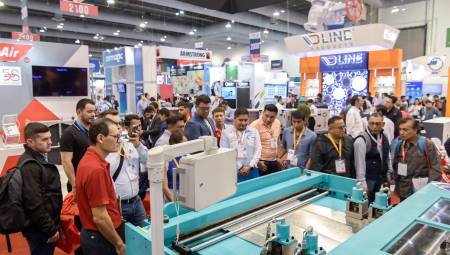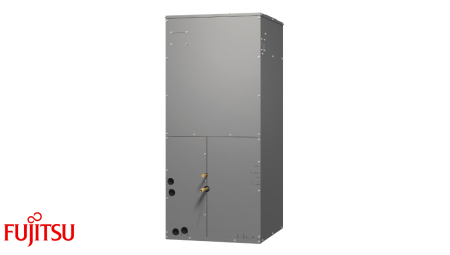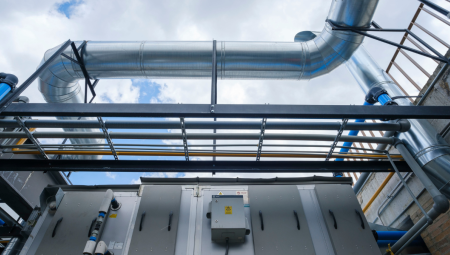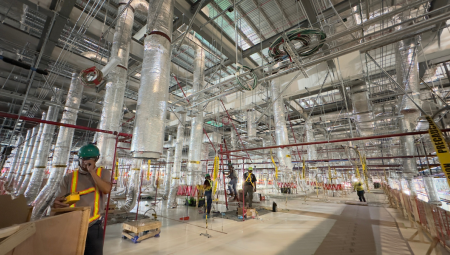Cooling spaces using hydronic systems is presented as an opportunity for small residential and commercial spaces with interesting energy savings and generation of optimal conditions for users.
Traditionally, radiant systems have been used for heating by circulating a hot fluid through PEX (criss-cross polyethylene) pipe or copper placed inside the floor, on walls or ceilings. This energy travels across the surface without heating the space itself, but levels the temperature of objects or other elements that are colder upon contact with you.
Radiant cooling has the same principle, except that a cold fluid is used by pipe circuits or capillary pipe mats normally placed on walls and ceilings. These elements then absorb the radiant energy of people and their surroundings, thereby lowering the temperature of the space evenly.
Difference between hydronic and air systems
The biggest difference between a radiant cooling ceiling and an air cooling system is the energy used to transport the cold. Air cooling uses only convection, while radiant ceilings use a combination of radiation and convection. This amount of radiated temperature transfer can be 55% and convection uses the remaining percentage. With radiant ceilings, thermal transfer occurs through a network emitting waves from users that release heat and its surroundings to a cold roof. On the other hand, convection first cools the room by contact with the cold ceiling, creating convective currents in the space that transfer heat from its source to the ceiling where it is absorbed.
Traditionally, HVAC systems are designed to work with air all the time. In turn, hydronic systems have a part of air and another of water that separates the tasks of ventilation and thermal conditioning in spaces by using the primary aerial distribution to meet the ventilation requirements, and the secondary hydraulic distribution system to condition the temperature of the space. These systems reduce the amount of air transported in constructions significantly because ventilation is provided by outdoor air systems without affecting the fraction of recirculating air.
Radiation provides most of the cooling, using water as a means of transport. Thanks to the physical properties of water, hydronic radiant cooling systems can remove a certain amount of thermal energy using less than 5% of energy in fans that might otherwise be needed. The separation of ventilation and cooling tasks not only improves comfort conditions, but also improves indoor air quality, as well as system control and zoning. Hydronic systems combine mechanisms to control the temperature of space surfaces with central air handling systems.
In this way most of the cooling is provided by radiation, using water as a means of transport, which thanks to its physical properties allows to remove good amounts of heat using less than 5% of the amount of energy that would be necessary to drive fans in a similar application. The separation between cooling and ventilation not only improves comfort conditions, but also increases indoor air quality as well as allowing control and zoning of the system.
The cooling of non-residential construction in the U.S. contributes significantly to electrical energy consumption and peak energy demand. Some of the electrical energy used to cool buildings is used by fans that transport cold air through ducts. The typical energy component is divided as follows: 31% lighting, 13% people, 14% air transport, and 6% per equipment (in the graph this is considered as 62.5% with the cooling label (approximately 37% of the energy consumption is used in air transport and the remainder in the operation of the compressor.
Since large surfaces are available for heat exchange in hydronic cooling systems (usually the entire floor or ceiling), the cooling temperature is just below that of the room temperature, and by the fact that the refrigerant can be kept at high temperature levels, the use of heat pumps with high coefficient of performance, Cooling towers, night cooling, or some combination of these can reduce energy expenditure. At the same time, cooling systems reduce problems due to leaks in ducts since they use much less ventilation air and because the air is conditioned only to reach room temperature and not precisely to cool it.
Another benefit is that ventilation through DOAS systems and their duct work needs only 20% of the space required by other HaVAC systems, which also reduces costs. These systems can be used successfully in spaces such as: hospitals, offices, libraries, museums and asylums, among others. In addition, hydronic systems, in some cases (according to the characteristics of the pipe), can be used to heat or cool the same spaces.
Simulations in specialized software show that in temperate/warm climates only between 10 and 20% of the replacement air is outside. This fraction of the replacement air is necessary to ventilate buildings sufficiently, allowing to maintain a high level of indoor air quality.
-
An outdoor air management system (DOAS) A new HVAC system called DOAS (Dedicated Outside Air System) uses 100% outdoor air in each conditioned space by means of a constant volume air unit with all energy recovery. In addition to ventilating each space, the DOAS improves humidity control and therefore practically eliminates problems of microbes or any other situation related to the syndrome of the sick building.Your outdoor unit uses total energy recovery equipment and enthalpy wheel to cool and moisten the outside air during the summer. This helps to reduce the thermal load and with it it is possible to have smaller cooling equipment, and the enthalpy wheel also works during the winter allowing the use of smaller heating and humidification plants, and in turn energy consumption.
This solution combined with radiant cooling roofs decreases the threat of contamination, since no air is recirculated and therefore no biological or chemical agents are released in other parts of the construction. On the other hand, the presence of these agents is diluted or weakened.
-
Authors:













